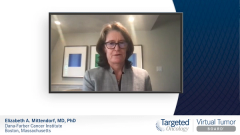
Early Stage Options for Patients With Metastatic TNBC
Dr Rugo educates on early stage treatment options and molecular testing guidelines for patients with metastatic triple-negative breast cancer.
Episodes in this series

Hope Rugo, MD: Our goal in looking at all new treatments for triple-negative disease is to improve survival and outcome for patients with metastatic breast cancer but also to move these therapies into the early stage setting as quickly as possible to try to prevent metastatic disease. This is the goal of many of the clinical trials that are going on. We’ve already seen a press release suggesting that adding the immunotherapeutic agent pembrolizumab to neoadjuvant chemotherapy might improve event-free survival from the KEYNOTE-522 trial. We also see that the addition of atezolizumab to nab-paclitaxel, anthracycline-based neoadjuvant regimen improves pathologic complete response. We are making progress in the early stage setting despite this unfortunate situation for this patient.
The patient presents with visceral disease in her lung and liver, and she has moderate symptoms. What’s her prognosis? The median survival overall for patients who present with metastatic triple-negative breast cancer is quite unfortunate. There are subtypes of triple-negative breast cancer that have more indolent course triple-negative cancers that express the androgen receptor. For example, rare subtypes, such as apocrine triple-negative breast cancer, may have a much longer median overall survival. But for the classic highly proliferative visceral-dominant triple-negative breast cancer, median survival is quite short.
However, we now have new regimens that are available to treat these cancers. For patients who have metastatic triple-negative breast cancer, the first test we should be obtaining is PD-L1 testing. We have 2 tests that we can do, including the SP142 assay used for this patient. If SP142 is negative, we generally will test the tumor with CPS [combined positive score] using the 22C3 antibody. Although these tests both have about a 38% to 42% positive rate in metastatic triple-negative breast cancer, the results do not completely overlap, so it’s possible that you would find a patient whose tumor was positive with 1 test and not the other. Both tests make the patient eligible to receive an immune checkpoint inhibitor. That’s very important, because using the immune checkpoint inhibitor, atezolizumab, has improved median overall survival by 7.5 months in the final analysis of the IMpassion130 trial. The addition of pembrolizumab to chemotherapy in the first-line setting in patients with PD-L1–positive disease has improved progression-free survival by a little over 4 months. Overall survival data have not yet been presented.
Transcript edited for clarity.












































